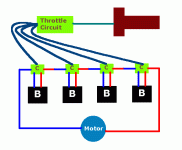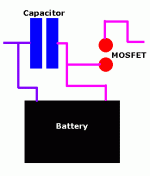safe
1 GW
- Joined
- Dec 22, 2006
- Messages
- 5,681
A PWM Controller For Each Cell?
 Here's an idea...
Here's an idea...
I've proposed something in the past I called "Distributed Pulse Width Modulation" before as a technique to implement a Low Voltage Cutoff and other functions for each cell. In that idea the PWM was done by a single master that was then connected to the MOSFET's distributed to the cells in a daisy chain configuration.
Where I'm taking a step forward with this is now I'm thinking:
"Well heck... do we really need a 'master' controller to supervise the others?"
...and I came to the conclusion that maybe you do not.
What if you had a small controller with nothing but a PWM logic part, a capacitor to hold the temporary charge of the previous battery in the daisy chain and a MOSFET to act as the gate. These small controllers might be made for a very low price, so maybe they only cost $5 each. Since in a daisy chain the voltage difference between one point and the next is small the MOSFET's need not be so high powered to handle it and can be made cheaply. (this was already figured out before, big voltage differences at the gate mean higher heat, so lower the difference and you lower the heat) It's not necessary for the PWM to be synchronized because the capacitor will hold whatever charge is delivered from the previous cell in the daisy chain.
This is how it might work...
The throttle is set up so that all the controllers see more or less the same throttle voltage. Each controller has a voltage cutoff that is appropriate for the type of battery chemistry that you are using. (so SLA would be 10 volts, Nickel 1.0 volts, LiFePO4 2.5 volts) Amazingly you could even MIX chemistries with this idea. The throttle would then allow that cell to deliver it's current as long as it was able to do it and then once it cut out everything would be shut down because the daisy chain would be broken. You could still do balancing if you wanted, but it would not be required.
If you really wanted to get sophisticated you could use a centralized monitoring system to watch the cell voltages and you could control the THROTTLE signal to the controllers. This would do the best possible job of balancing because the "runts" could be given less throttle than the stronger cells. Cell voltage measuring would be easy to do within the controllers because when the MOSFET's are closed there is no "common mode voltage" to worry about. (so you measure in the gaps between PWM pulses)
 The THROTTLE.
The THROTTLE.
...this way you compartmentalize the problem. Each cell gets it's own controller and you only deal with the throttle as the way to control it. All the low voltage cutoff and even the high voltage cutoff functions are delegated to the controller.
Charging might also use the SAME controllers in a way where each controller has a separate wire that allows a DC voltage to be given to it. The control logic for charging could also be built into the controller.
Either this is "brilliant" or I've missed something... :lol:
 Okay... find a hole in my idea...
Okay... find a hole in my idea...
This actually might leapfrog past the idea of a daisy chained PIC system which relys on communication between cells using software. This reduces the problem because the MOSFET's effectively "divide and conquer" the "common mode voltage" problem that is at the root of all the difficulties.
This would deliver most everything that a "Smart Battery" could give without much (or any) of the software to worry about.
I've proposed something in the past I called "Distributed Pulse Width Modulation" before as a technique to implement a Low Voltage Cutoff and other functions for each cell. In that idea the PWM was done by a single master that was then connected to the MOSFET's distributed to the cells in a daisy chain configuration.
Where I'm taking a step forward with this is now I'm thinking:
"Well heck... do we really need a 'master' controller to supervise the others?"
...and I came to the conclusion that maybe you do not.
What if you had a small controller with nothing but a PWM logic part, a capacitor to hold the temporary charge of the previous battery in the daisy chain and a MOSFET to act as the gate. These small controllers might be made for a very low price, so maybe they only cost $5 each. Since in a daisy chain the voltage difference between one point and the next is small the MOSFET's need not be so high powered to handle it and can be made cheaply. (this was already figured out before, big voltage differences at the gate mean higher heat, so lower the difference and you lower the heat) It's not necessary for the PWM to be synchronized because the capacitor will hold whatever charge is delivered from the previous cell in the daisy chain.
This is how it might work...
The throttle is set up so that all the controllers see more or less the same throttle voltage. Each controller has a voltage cutoff that is appropriate for the type of battery chemistry that you are using. (so SLA would be 10 volts, Nickel 1.0 volts, LiFePO4 2.5 volts) Amazingly you could even MIX chemistries with this idea. The throttle would then allow that cell to deliver it's current as long as it was able to do it and then once it cut out everything would be shut down because the daisy chain would be broken. You could still do balancing if you wanted, but it would not be required.
If you really wanted to get sophisticated you could use a centralized monitoring system to watch the cell voltages and you could control the THROTTLE signal to the controllers. This would do the best possible job of balancing because the "runts" could be given less throttle than the stronger cells. Cell voltage measuring would be easy to do within the controllers because when the MOSFET's are closed there is no "common mode voltage" to worry about. (so you measure in the gaps between PWM pulses)
...this way you compartmentalize the problem. Each cell gets it's own controller and you only deal with the throttle as the way to control it. All the low voltage cutoff and even the high voltage cutoff functions are delegated to the controller.
Charging might also use the SAME controllers in a way where each controller has a separate wire that allows a DC voltage to be given to it. The control logic for charging could also be built into the controller.
Either this is "brilliant" or I've missed something... :lol:
This actually might leapfrog past the idea of a daisy chained PIC system which relys on communication between cells using software. This reduces the problem because the MOSFET's effectively "divide and conquer" the "common mode voltage" problem that is at the root of all the difficulties.
This would deliver most everything that a "Smart Battery" could give without much (or any) of the software to worry about.



